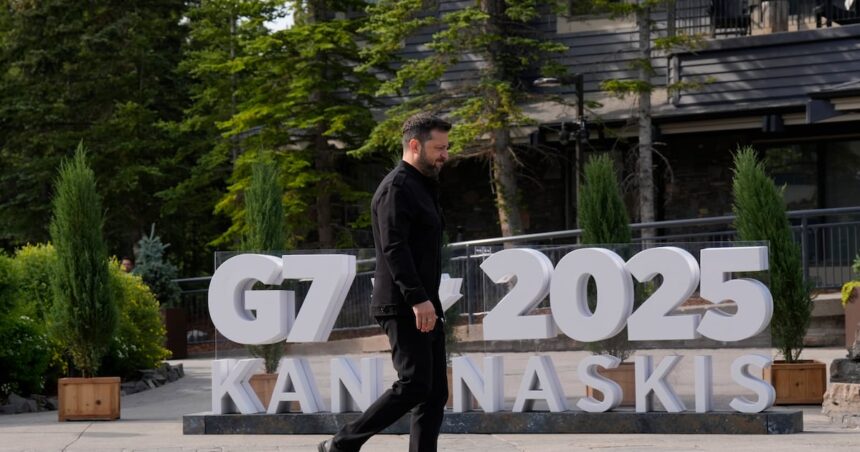Standing at the edge of the elegant G7 conference room in Quebec City, I watched Ukrainian President Volodymyr Zelenskyy embrace Canada’s newly elected Prime Minister Mark Carney with the familiar weariness of a wartime leader. The moment captured the essence of what had just transpired – Canada’s landmark commitment of $4.3 billion in new support for Ukraine, the largest single aid package Ottawa has offered since Russia’s full-scale invasion began in 2022.
“This is not charity – this is an investment in our shared security,” Carney declared moments after the announcement, his banker’s precision giving way to unexpected emotional gravity. “While Russia continues its illegal war, Canada stands unwavering with Ukraine for as long as it takes.”
The package represents a significant shift in Canada’s approach. Rather than the piecemeal assistance that characterized previous governments, this comprehensive aid bundle combines military support, economic stabilization measures, and humanitarian assistance designed to address both immediate battlefield needs and longer-term reconstruction challenges.
Defense Minister Anita Anand, who joined the announcement, specified that $2.1 billion would go directly toward Ukrainian defense capabilities, including advanced air defense systems, precision artillery, and critical battlefield technologies that Ukrainian commanders have desperately sought. An additional $1.5 billion is earmarked for economic stabilization, with the remaining funds allocated to humanitarian aid and reconstruction initiatives in areas liberated from Russian occupation.
President Zelenskyy, dressed in his now-iconic olive-green military attire, appeared genuinely moved. “Canadian support has always been among the most principled and consistent,” he told the assembled press corps. “This new commitment comes at a crucial moment when Russia is escalating attacks on our energy infrastructure before winter.”
Behind the public declaration lies a complex diplomatic reality. Sources close to the negotiations revealed that Canada’s package was carefully timed to coincide with the G7 summit, creating pressure on other member nations to match or exceed this level of support. A senior Canadian official, speaking on condition of anonymity, admitted: “We wanted to set the tone for the summit. Ukraine fatigue is real, but this moment demands renewed commitment.”
The announcement follows weeks of intensified Russian missile and drone strikes across Ukraine, targeting electrical substations and heating facilities as temperatures drop across Eastern Europe. The Ukrainian energy ministry reports that nearly 40% of the country’s power generation capacity has been damaged or destroyed in recent months.
The financial package has not been without domestic criticism. Opposition leader Pierre Poilievre questioned the timing and scale of the commitment amid Canada’s own economic challenges. “Canadians support Ukraine, but they’re struggling with inflation and housing costs,” Poilievre said during Question Period last week. “The government needs to explain how this spending aligns with domestic priorities.”
However, public opinion polls suggest Canadians broadly support continued aid to Ukraine. A recent Angus Reid survey found 68% of respondents favor maintaining or increasing assistance, though support has declined somewhat from the 76% recorded in early 2023.
Economic analyses indicate potential benefits for Canada beyond geopolitical considerations. The Canadian Commercial Corporation estimates that approximately 30% of military aid will return to the Canadian economy through domestic defense industry contracts. Meanwhile, Canadian engineering and construction firms are positioning themselves for reconstruction projects in Ukraine, valued potentially at hundreds of billions of dollars over the coming decade.
“This isn’t just about stopping Putin,” explained Dominique Arel, Chair of Ukrainian Studies at the University of Ottawa. “It’s about what kind of international order we want to live in. One where might makes right, or one where sovereignty matters.”
For Ukrainians on the ground, the aid package represents something more immediate. Oleksandra Matviichuk, head of the Center for Civil Liberties in Kyiv and Nobel Peace Prize laureate, described the tangible impact: “When we have air defense, fewer children die. When we have economic support, fewer families go hungry. Every dollar matters in ways most Canadians cannot imagine.”
The timing of Canada’s announcement carries particular significance in the broader geopolitical context. With American support fluctuating amid electoral politics and European nations facing energy challenges, Canada’s clear signal of long-term commitment provides critical reassurance to Kyiv.
At the G7 sessions following the announcement, finance ministers and central bank governors discussed innovative approaches to utilizing frozen Russian assets for Ukraine’s benefit. Canada has been among the most vocal proponents of directing the interest from approximately $300 billion in immobilized Russian central bank reserves toward Ukrainian reconstruction.
As the conference proceeded, I observed Ukrainian Finance Minister Serhiy Marchenko quietly consulting with his Canadian counterpart about implementation timelines. The urgency was palpable – Ukrainian officials know that battlefield momentum and civilian morale depend on timely delivery of promised aid.
For Ukraine, the significance extends beyond the financial figures. “This is about endurance,” President Zelenskyy emphasized during a private briefing with select journalists. “Russia is betting on Western support collapsing before their economy does. Every substantial commitment like Canada’s disrupts that calculation.”
As winter approaches and Ukraine faces another season of energy shortages and hardship, Canada’s $4.3 billion pledge represents more than fiscal support – it’s a statement about the durability of international resolve in the face of protracted conflict. Whether this commitment will inspire similar action from other G7 nations remains the critical question as the summit continues.






